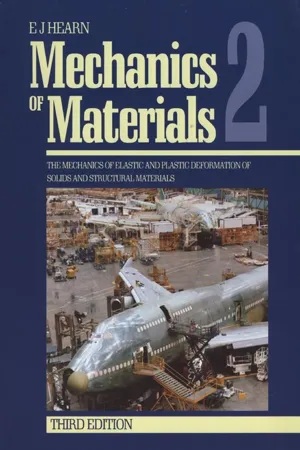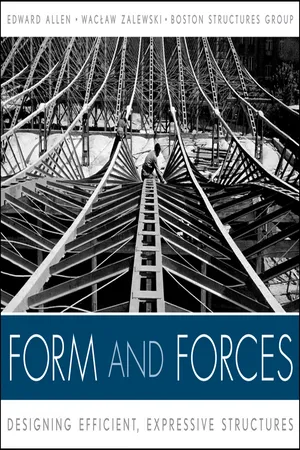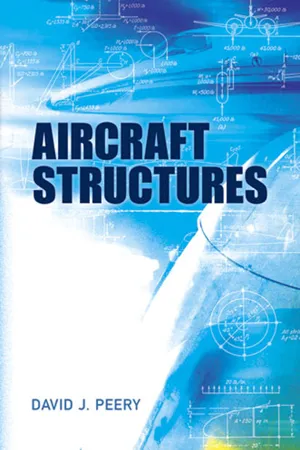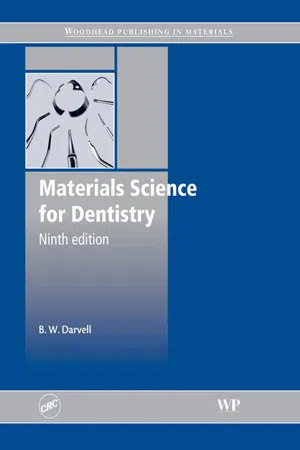Technology & Engineering
Second Moment of Area
The Second Moment of Area, also known as the moment of inertia, is a measure of an object's resistance to bending. It quantifies how the mass is distributed around an object's cross-sectional area. In engineering and technology, it is crucial for analyzing the structural behavior of beams and other components under bending loads.
Written by Perlego with AI-assistance
Related key terms
Related key terms
1 of 4
Related key terms
1 of 3
4 Key excerpts on "Second Moment of Area"
- eBook - ePub
Mechanics of Materials 2
The Mechanics of Elastic and Plastic Deformation of Solids and Structural Materials
- E.J. Hearn(Author)
- 1997(Publication Date)
- Butterworth-Heinemann(Publisher)
§1.8 . Before proceeding with the various methods of solution of unsymmetrical bending problems, however, it is advisable to consider in some detail the concept of principal and product second moments of area.1.1 Product Second Moment of Area
Consider a small element of area in a plane surface with a centroid having coordinates (x , y ) relative to the X and Y axes (Fig. 1.2 ). The second moments of area of the surface about the X and Y axes are defined asI=x x∫d A andy 2I=y y∫d Ax 2(1.1)Fig. 1.2Similarly, the product Second Moment of Area of the section is defined as follows:I=x y∫d Ax y(1.2)Since the cross-section of most structural members used in bending applications consists of a combination of rectangles the value of the product Second Moment of Area for such sections is determined by the addition of theIxyvalue for each rectangle (Fig. 1.3 ),Fig. 1.3i.e.I= A h kx y(1.3)where h and k are the distances of the centroid of each rectangle from the X and Y axes respectively (taking account of the normal sign convention for x and y ) and A is the area of the rectangle.1.2 Principal second moments of area
The principal axes of a section have been defined in the introduction to this chapter. Second moments of area about these axes are then termed principal values and these may be related to the standard values about the conventional X and Y axes as follows.Consider Fig. 1.4 in which GX and GY are any two mutually perpendicular axes inclined at 8 to the principal axes GV and GU . A small element of area A will then have coordinates (u , v ) to the principal axes and (x , y ) referred to the axes GX and GY . The area will thus have a product Second Moment of Area about the principal axes given by uvdA - eBook - ePub
Form and Forces
Designing Efficient, Expressive Structures
- Edward Allen, Waclaw Zalewski(Authors)
- 2012(Publication Date)
- Wiley(Publisher)
moment of inertia, I , of that section.Substituting this latter equation into the one previous:Up to the limit of its safe load-carrying capacity, the resisting moment of a beam is equal to the applied external bending moment, M . Substituting M for M resist and rearranging terms, we arrive at the fundamental equation for bending stress that is applicable to beams of any cross-sectional shape:18.1where:is the maximum bending stress in the beam,M is the bending moment,c is the perpendicular distance from the neutral axis to the extreme fiber, andI is the moment of inertia.I , the moment of inertia of a beam cross section, represents in a single, miraculously powerful constant all the geometric characteristics and dimensions that affect the elastic behavior of a beam. Its units are in.4 or mm4 .For any given beam shape, c and I are constants. If I/c is defined as the section modulus, S , then:18.2To find the bending stress at any distance y from the neutral axis, we use another form of equation [18.1 ]:18.3Finding the Moment of Inertia of Any ShapeTo use these expressions, we need to be able to find a numerical value for the moment of inertia, I , of any shape. We have defined moment of inertia as the sum for all the thin layers of material in the beam of the cross-sectional area of each layer times the square of its distance from the neutral axis (Figure 18.22 ).For a rectangular section, y is equal to half the height of the beam, d/ 2, and b , the width of the beam, is constant. Using calculus-based notation, each thin layer has a thickness of dy . The area of each thin layer is therefore b dy , and its distance from the neutral axis is y . We can find the moment of inertia for a rectangular section by integration:This verifies an identical expression that we derived by a different path in Chapter 17. It also typifies a method for finding the moment of inertia of any regular geometric shape. - eBook - ePub
- David J. Peery(Author)
- 2013(Publication Date)
- Dover Publications(Publisher)
CHAPTER 18SPECIAL METHODS OF ANALYSIS
18.1. Area Moments. The method of virtual work may be used in obtaining the deflections or the redundant forces for any type of structure. However, other methods are frequently more convenient to use in the analysis of certain special types of structures. Several of these methods will be discussed in this chapter.The method of area moments is very convenient to use in finding beam deflections or in analyzing statically, indeterminate beams. The line AB inFig. 18.1(a )represents the elastic curve of an initially straight elastic beam. The deflections are assumed small, as in previous problems. The angular deformation d in a length dx is found from Eq. 14.3.FIG . 18.1.The total angle AB between tangents to the elastic curve at points A and B is obtained as a sum of all of the increments d .The integrand is equal to the area under the M /EI diagram between the points, which is shown as the shaded area inFig. 18.1(b ). Equation 18.1 may be stated as follows:First Area Moment Principle. The change in slope of the elastic curve between any two points of a beam is equal to the area under the M/EI diagram between the points .The distance AB ofFig. 18.1(a )may be obtained as the sum of the increments x d .Substituting the value of d from Eq. 14.3,where the integrand represents the moment of the shaded area under the M /EI curve about point A . This procedure may be stated as follows:The area moment principles were published by Professor Greene of the University of Michigan, in 1873. They have been used extensively in structural analysis and design.Second Area Moment Principle. The deflection of point A on the elastic curve of a beam from a tangent to the elastic curve at point B is equal to the moment of the area under the M/EI diagram between the points, taken about point A.The method of virtual work is sometimes used in the derivation of Eqs. 18.1 and 18.3. In finding the rotation AB , a unit virtual couple would be applied at A and resisted at B , producing a virtual bending moment of m = 1. Thus Eq. 16.20 corresponds with Eq. 18.1 when m = 1. In obtaining the deflection AB , a unit virtual load is applied at point A and the beam is assumed to be fixed at point B , as in Fig. 16.20 . The virtual bending moment which is substituted into Eq. 16.20 is now m = x - eBook - ePub
- B W Darvell(Author)
- 2009(Publication Date)
- Woodhead Publishing(Publisher)
Fig. 2.14 ).Fig. 2.14 Pre-stressing always involves balanced forces.Effectively, pre-stressing also occurs in any material where there is a differential dimensional change. For example, polymerization shrinkage and water-sorption in filled resins (6§2.12 ), and in any composite or structure where there are phases of differing thermal expansion coefficient (5§5.5 ). It should be recognized that the outcome may be advantageous or disadvantageous, depending on the circumstances.§3 The Second Moment of Inertia
So far we have assumed rectangular beams, but this is plainly not a general enough system to be of use in understanding even orthodontic wires. In particular, the summation of the forces considered in connection with Fig. 2.10 above was on the assumption of symmetry about the z -axis. This is not an essential condition. What is needed is a summation over the entire area of an arbitrary cross-section, element by element, taking note of the stress acting on each. Thus, from equation 2.17 , the element of force dF acting on an area element dA is given by:dF dA= E ⋅yr c(3.1)since dF/dA is a stress. Hence, the moment of that force, from equation 1.5 , isdM dA=dF dA⋅ y = E ⋅y⋅ yr c(3.2)where y is still the perpendicular distance from the neutral surface. Integrating over the entire cross-section, equating that integral to the known (total) moment, M, of the external forces, we get:M =∫=dM dA. dA∫=E.r cy 2. dAE.r c∫y 2. dA(3.3)This rearrangement has effectively separated the elements of equation 3.2
Index pages curate the most relevant extracts from our library of academic textbooks. They’ve been created using an in-house natural language model (NLM), each adding context and meaning to key research topics.
Explore more topic indexes
Explore more topic indexes
1 of 6
Explore more topic indexes
1 of 4



